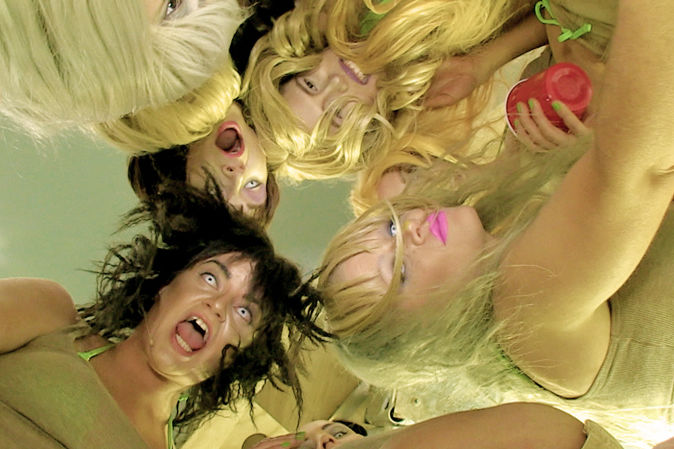Latest Schnitzer Museum Art Exhibit Works to Demystify Technology through Weaving
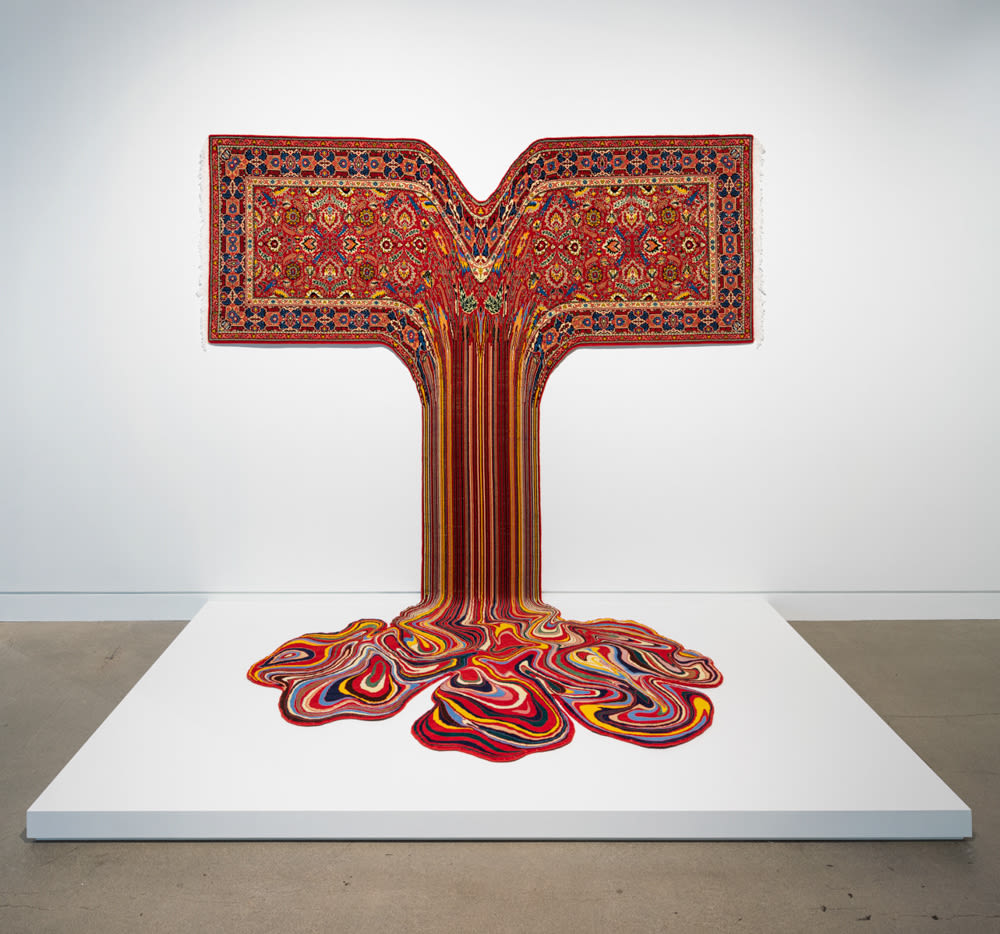
Faig Ahmed's Gautama
Opening night of Weaving Data, at Portland State University’s Jordan Schnitzer Museum of Art. A chorus of voices, staff walkie- talkies, and “test, test” coming through the PA system bounced off the cement floors and into the high ceilings of the two-story exhibit. But if you stood in the right spot on the lower level, you could hear Joan Baez and her sister Mimi Fariña singing “Bread and Roses.”
The lyrics, borrowed from James Oppenheim’s 1911 poem of the same name, emanate from a clear dome hung from the museum’s ceiling that creates an isolated soundscape without walls. Textile workers striking against poor working conditions in Lawrence, Massachusetts, in 1912— then the world’s leading producer of worsted wool—adopted “Bread and Roses” as a slogan.
Playing in front of a tapestry depicting protest imagery, the song introduces the audio portion of Portland-based artist Vo Vo’s work Still Fighting: Textile Workers of Lawrence, and is followed by a series of collected interviews with surviving witnesses and participants of the strike. The mostly immigrant, mostly women workers were not just after bread (sustenance) but also roses (the means to live a life with some affordance of beauty). Their strike sparked a series of other strikes in the area, setting precedent for labor unions across the country.
Vo’s grandparents lived and worked in Lawrence’s textile mills, and the strike mirrors the artist’s own long history with textiles, which started with industrial production in a sweatshop as a child.
Vo’s piece fits snuggly into the larger narrative of the exhibit, which features works of eight other local and international artists working at the many intersections of textiles and technology.
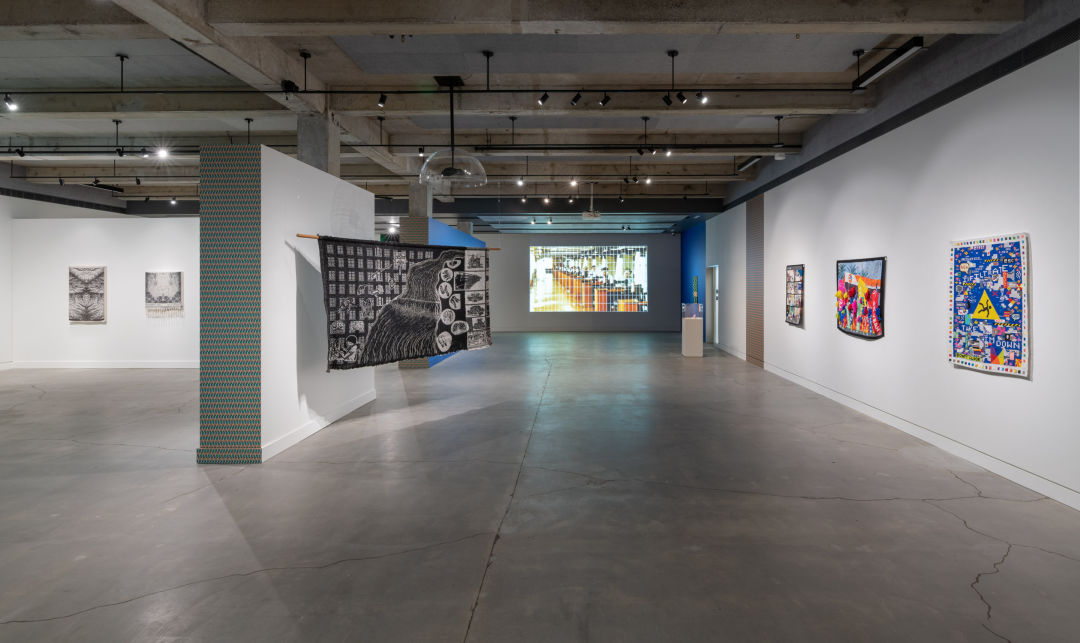
Vo Vo's Still Fighting: Textile Workers of Lawrence
Weaving Data was put together by Theo and Nancy Downes-Le Guin. Theo is the proprietor of Upfor, a Pearl District gallery that has recently pivoted to an art consulting firm. Nancy taught art in Portland Public Schools for decades, as well as at the Portland Art Museum, where she is currently a docent. Despite their separate, decades-long careers in the field, this show is the couple’s first official collaboration.
Initially, Theo was tapped to curate the exhibition solo, but found he was constantly consulting Nancy and soon brought her on to co-curate. Maryanna Ramirez, the museum's director, was referred to Theo (who is the son of famed Portland speculative fiction author Ursula K. Le Guin) because of his reputation for showing art with a technological bent at Upfor. The museum wanted to craft an exhibit that might draw together disparate departments of the university, departments that usually wouldn’t find themselves in an art museum.
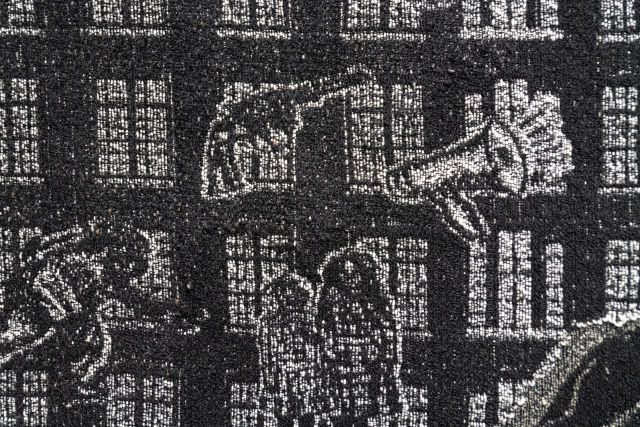
Detail of Vo Vo's Still Fighting: Textile Workers of Lawrence
Theo floated the idea of weaving, which he knew laid the groundwork for some of the first computer technology in the early 1900s. The first automated Jacquard loom, which weaved patterns directly into its fabric via a punch card system, created the technology that went on to aid in recording the US census, before being adopted by IBM engineers to program the first proto-computers. The ostensibly rudimentary technology remained at the forefront of the industry until the invention of magnetic disks in the ’80s.
Today, of course, technology is more of a magic wall most of us stake our livelihoods on, but have no clue as to how a lot of it works. It’s almost a running joke that nobody, or, rather importantly, only a select few, fully comprehend how, say, an iPhone operates. This mythos created around technology is problematically exclusionary, if not dangerous. A goal of this show, the Downes-Le Guins say, is to critique the lack of democratization of technology today.
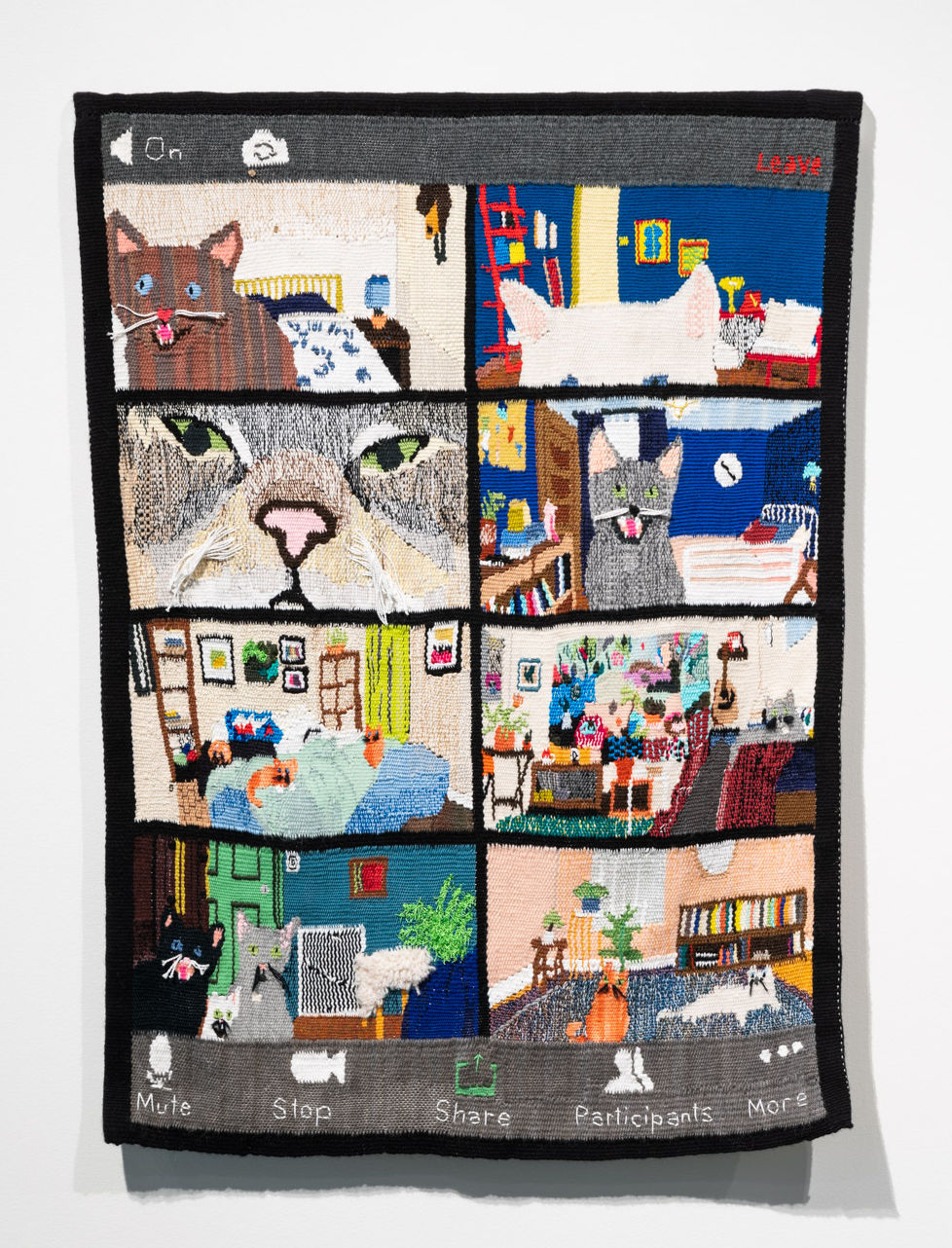
Kayla Mattes's Zoom Cats
Kayla Mattes’s hand-woven tapestries are a good starting point. They depict scenes from life around her apartment in LA, like gas station inflatable tube people—with an iPhone camera border—and a Zoom call filled with cats. Originally, she took on the lo-fi medium for its accessibility, but something about capturing “high-technology” with “low” clicked.
Mattes’s Blue Screen of Death collects panic-inducing computer messages compiled across decades: an icon of a falling stick figure in a taxicab yellow triangle is central, conjuring dial-up nightmares; a collage of familiarly alarming messages like, “press any key,” “error,” “DON’T CLICK,” “ABORT,” and of course, “HELP” build a compartmentalized cube of anxiety. It captures the learned helplessness of being “just a human” in a technological world. (I took a picture with my phone.)
Ahree Lee’s work, also created on a hand loom in LA, speaks explicitly to the history of women in technology. Disrupting the Industry, a bar graph woven of cotton, linen, and copper, catalogues the number of women who earned computer science degrees between 1966 and 2010. Copper bars pinch the midsection of the graph’s pliable fibers like staples, marking the zenith of women in the industry that foreshadowed a sharp decline, 1984.
Anything paired with the buzzword “disrupt” carries a certain tech-bro arrogance today. And Lee’s work seems to pinpoint when exactly the narrative of what she calls the “teenage-boy hacker” took over the industry.
While Weaving Data has the educational feeling of an exhibit at a university museum, the informative videos and editorial materials are far from patronizing, in large part due to a cautious hand in curating.
Theo says he’s often averse to heavily thematic shows, which Weaving Data absolutely is—he’d rather the curator be subordinate to the artists. However, he says the artists featured in this show were already asking the questions the show gets at, independently, “so we didn’t need to assert much of a curatorial voice.”
The narrative is created by putting artists working at different points of the conversation in the same room.

Detail of Faig Ahmed's Gautama
Faig Ahmed’s computer-designed carpets start out as reproductions of traditional Azerbaijani designs, but he bends them. Gautama, his piece displayed here, is a lush red runner about the size of a white board. The ornate rug’s corners are a precise replica of historical carpets, but the center melts into a vibrant pool, surreally dripping down the wall and into a marbled pool of saturated color on the floor.
In the artist’s words, the works comment on the simultaneous “preservation and change of culture.” Melding old with the new is sometimes awkward, often difficult, but more often than not, remarkable—if not a bit shocking. It’s likely you’ve stumbled on Ahmed’s disorienting works on your explore page.
The mission, Theo says, isn’t to help viewers “understand any better how an iPhone works,” or even necessarily encourage them to partake in creating technology. For him, the show works to unpack “the assumptions we make and the mysticism that we accept without question as we use these products, simply by analogizing ‘high technology’ to weaving.”
A few historical inclusions lend tangible—literally, there’s one you can touch—reference points to the allusions found in the modern artist’s work. Nancy sourced a time or memory ball from the Yakima tribe that she first saw on a trip to the Gorge. The wound hemp balls served as a type of journal for tribeswomen, recording life events with symbolic knots, beads, and shells.
A replica Incan quipu (this is the one you can touch—gently!), displays the knotted llama hair strings used in the 13th century to record things like census counts, taxes owed, passage of time, and the organization of armies.
Punch cards, the binary records that started it all, give the younger generation an idea of what this “ancient” technology looked like. “We know not all of our visitors are familiar with that—because they're born after the ’80s,” says Nancy, laughing.
These elements come together as an extremely cohesive exhibit. It’s balanced with works that both explicitly and implicitly show the past, present, and future of weaving. The result is a recontextualization of an art often, as Theo notes, “associated with historicism and indigeneity” as something not only extremely complex, but that precedes the technology that now runs our world.
Weaving Data
11 a.m.–5 p.m. Tue–Sat; on thru Apr 29 | Jordan Schnitzer Museum of Art at Portland State University, 1855 SW Broadway

